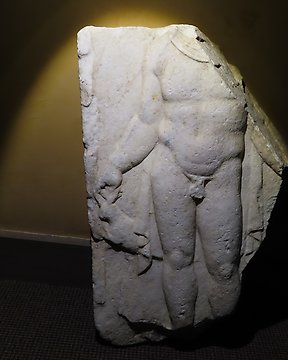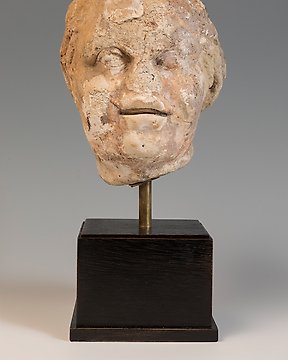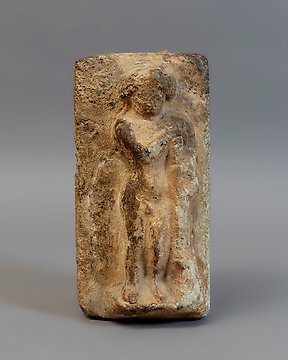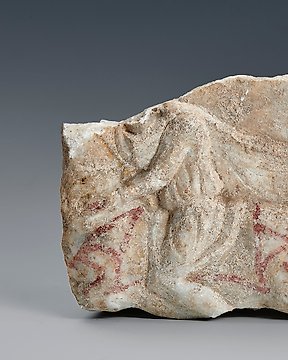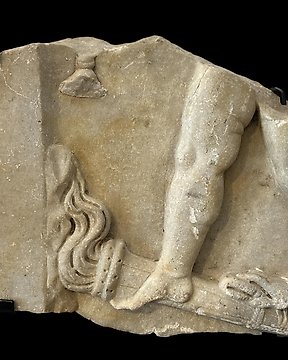
Romain antique Marbre Soulagement du sarcophage - 40.5 cm
Catawiki met continuellement à jour ses moyens techniques. La version de navigateur que vous utilisez actuellement est obsolète. Pour avoir la meilleure navigation possible, veuillez mettre à jour votre navigateur.
Vous pouvez définir vos préférences en matière de cookies en utilisant les boutons ci-dessous. Vous pouvez mettre à jour vos préférences, retirer votre consentement à tout moment, et voir une description détaillée des types de cookies que nos partenaires et nous-mêmes utilisons dans notre Politique en matière de cookies .
Nº 84074627
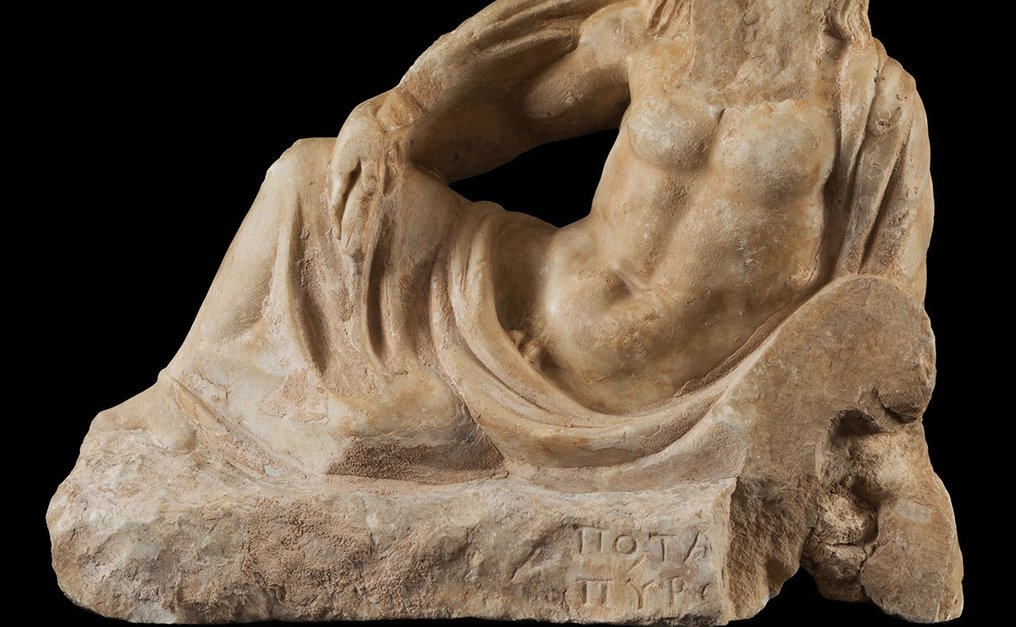
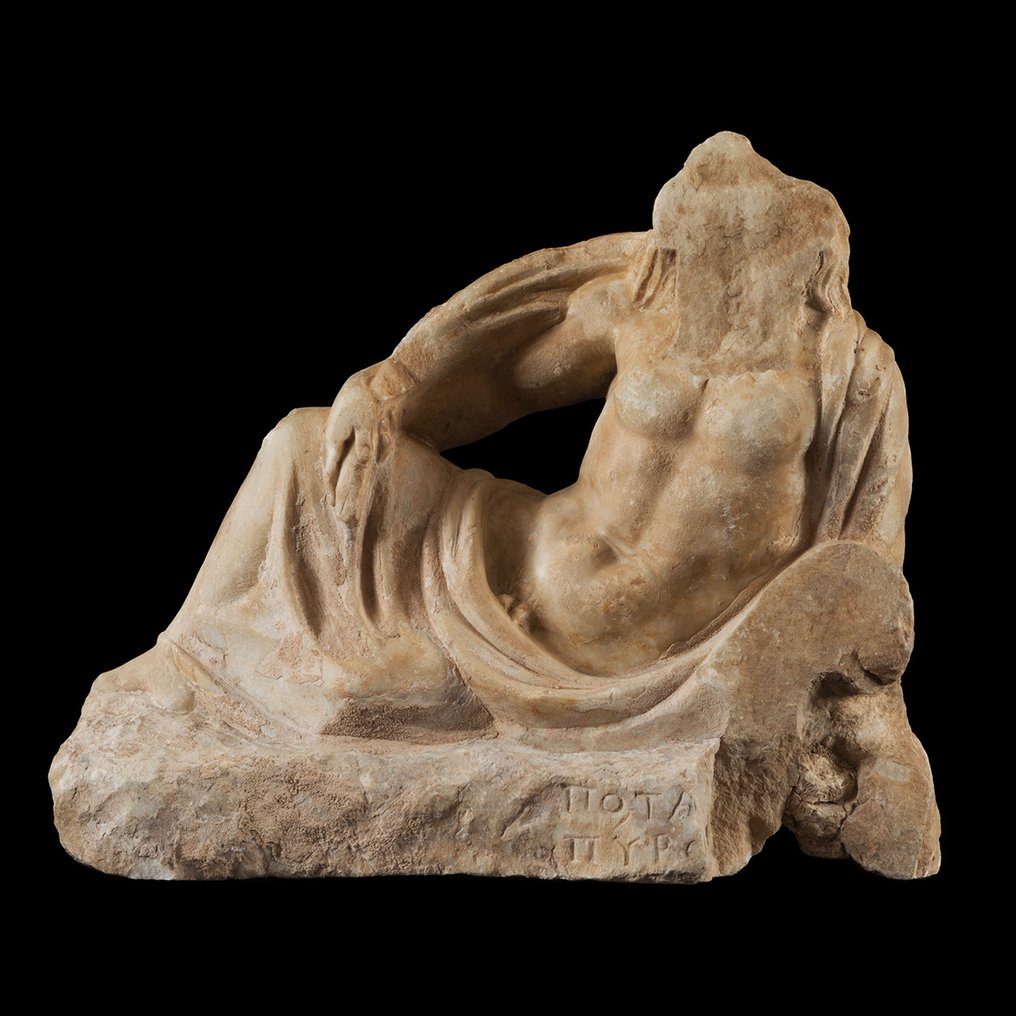

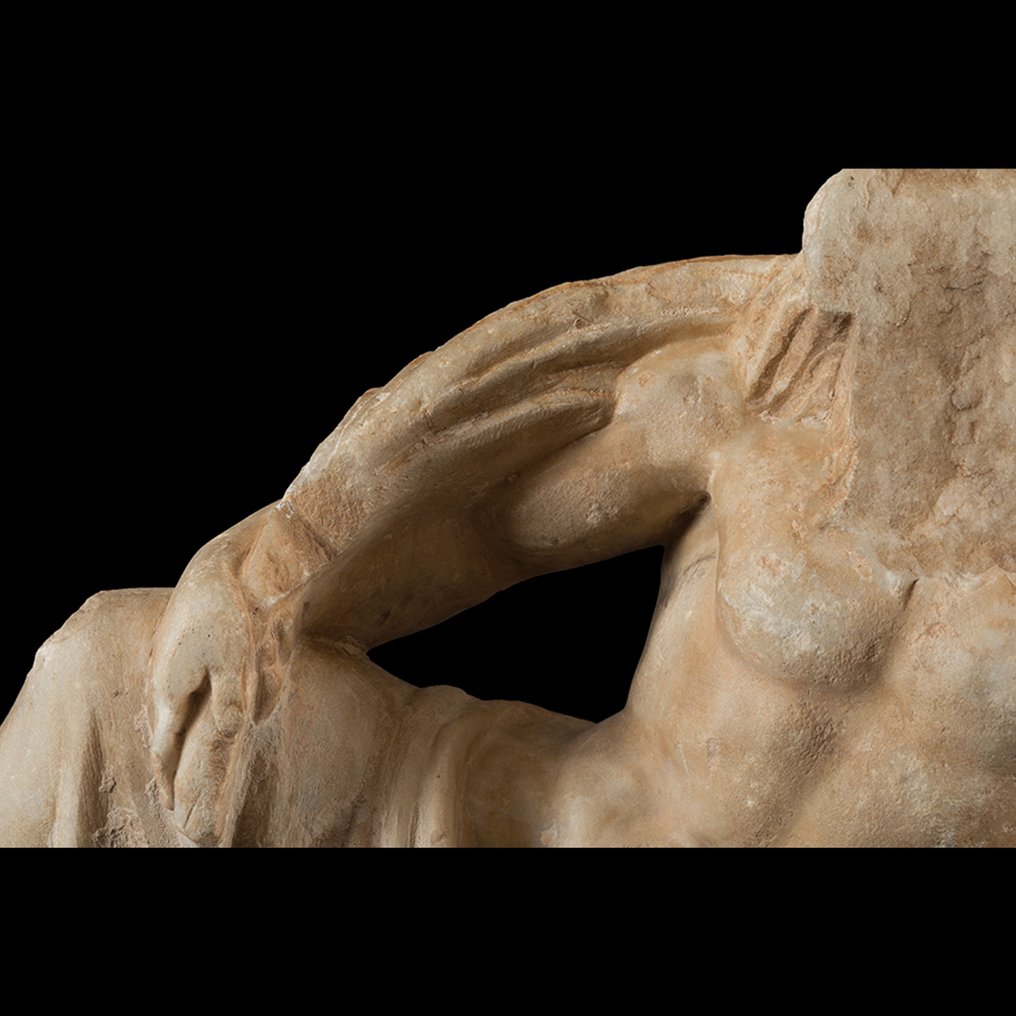
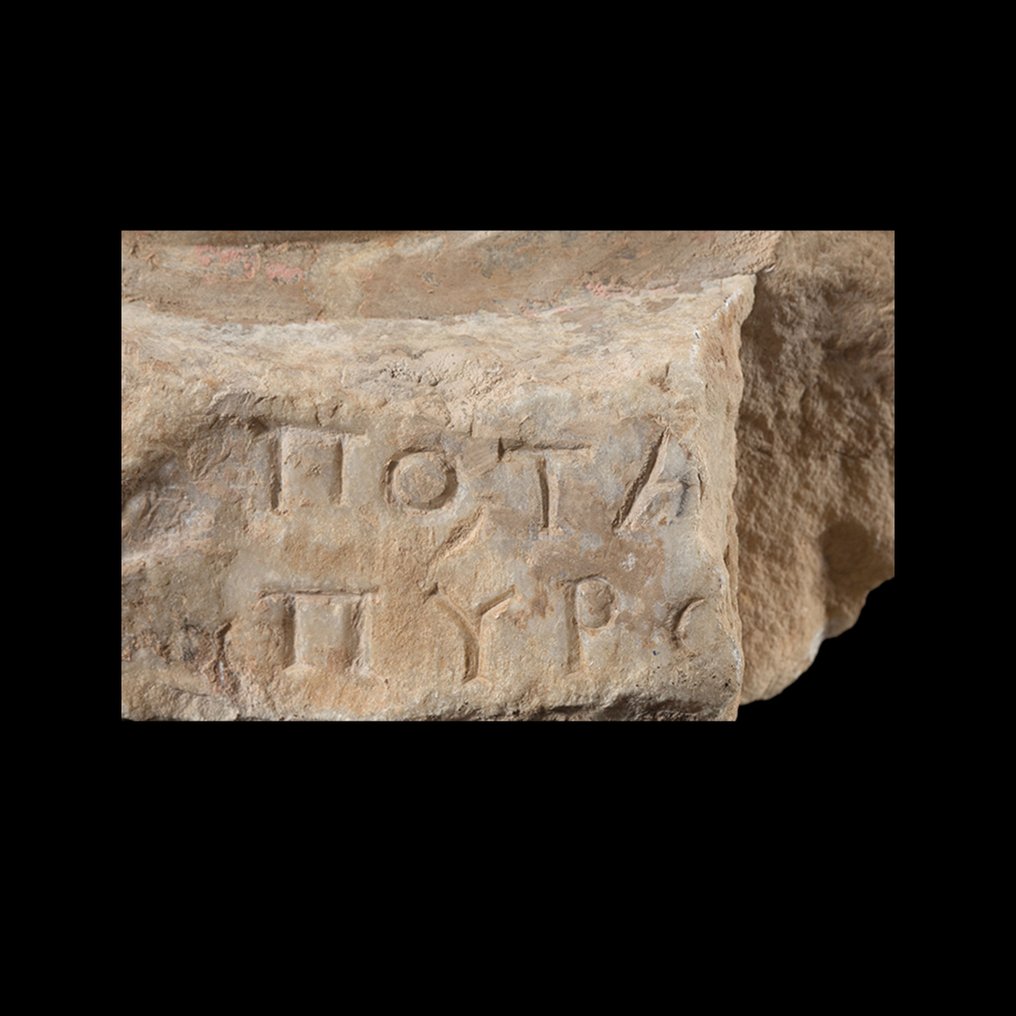
Sculpture of a fluvial divinity, river Sagarius
CULTURE: Roman Empire
EPOCA: 1st - 3rd century AD
MATERIAL: Marble
DIMENSIONS: 43 cm long and 38 cm high
PROVENANCE:
- Private collection, Mainz-Kastel, Germany. 1970.
CONSERVATION: Good state of preservation. It has lost the face and part of the lower corners. No restorations.
DESCRIPTION:
Sculpture carved in marble in round bulk representing a reclining mature man, of powerful anatomy, dressed in a cloak covering his legs and left shoulder, holding in his right hand a cornucopia. The man turns toward the viewer, facing the viewer. His legs are bent, the right leg raised and the left leg resting on the ground. Remains of long hair are preserved on both sides of the neck, and from the shape of the break in the head it can be deduced that this was a bearded man. The base on which it rests has an incised inscription.
It is the personification of the river Sagarius (or Sakarya), an important river in Turkey that flows through the central-eastern part of Asia Minor and empties into the Black Sea. It is the third longest river in the country and flows through the historical region of Phrygia. Already in the Greek arts the rivers were represented as male deities, generally men of mature age and strong muscular body. Hesiod stated that the river-gods were sons of the titans Oceanus and Thetis, primordial aquatic deities, and brothers of the nymphs. They were worshipped for their fertility-enhancing character, and some of them were considered founders of mythical lineages. In Rome they were usually represented as seen in the piece under study: men with long hair and beard, powerful musculature and reclining or seated position, dressed with a cloak covering only their legs and holding a branch or a cornucopia.
PARALLELS:
Fig. 1 Statuette of river god. Syria, Roman Empire, 1st-2nd century AD, bronze. British Museum, London, inv. 1902,0116.2.
Fig. 2 Statuette of river god. Hellenistic Greek or Imperial Roman, 1st century BC. - I A.D. Metropolitan Museum, New York, inv. 89.2.557.
Fig. 3 Statue of river god. Roman Empire, 2nd century A.D., marble. Museo Archeologico Nazionale di Napoli (Italy).
BIBLIOGRAPHY:
- FRIEDLAND, E. A.; SOBOCINSKI, M. G.; GAZDA, E. K., eds). The Oxford Handbook of Roman Sculpture. Oxford University Press. 2015.
- KLEINER, D. E. Roman sculpture. Yale University Press. 1992.
- KOUSSER, R. M. Hellenistic and Roman Ideal Sculpture: The Allure of the Classical. Cambridge University Press. 2008.
- OSTROWSKI, J. A. Personifications of rivers in Greek and Roman art. Jagiellonian University Press. 1991.
Notes:
- The piece includes authenticity certificate.
- The piece includes Spanish Export License.
- The seller guarantees that he acquired this piece according to all national and international laws related to the ownership of cultural property. Provenance statement seen by Catawiki.
#MorganNiquetCollection
Sculpture of a fluvial divinity, river Sagarius
CULTURE: Roman Empire
EPOCA: 1st - 3rd century AD
MATERIAL: Marble
DIMENSIONS: 43 cm long and 38 cm high
PROVENANCE:
- Private collection, Mainz-Kastel, Germany. 1970.
CONSERVATION: Good state of preservation. It has lost the face and part of the lower corners. No restorations.
DESCRIPTION:
Sculpture carved in marble in round bulk representing a reclining mature man, of powerful anatomy, dressed in a cloak covering his legs and left shoulder, holding in his right hand a cornucopia. The man turns toward the viewer, facing the viewer. His legs are bent, the right leg raised and the left leg resting on the ground. Remains of long hair are preserved on both sides of the neck, and from the shape of the break in the head it can be deduced that this was a bearded man. The base on which it rests has an incised inscription.
It is the personification of the river Sagarius (or Sakarya), an important river in Turkey that flows through the central-eastern part of Asia Minor and empties into the Black Sea. It is the third longest river in the country and flows through the historical region of Phrygia. Already in the Greek arts the rivers were represented as male deities, generally men of mature age and strong muscular body. Hesiod stated that the river-gods were sons of the titans Oceanus and Thetis, primordial aquatic deities, and brothers of the nymphs. They were worshipped for their fertility-enhancing character, and some of them were considered founders of mythical lineages. In Rome they were usually represented as seen in the piece under study: men with long hair and beard, powerful musculature and reclining or seated position, dressed with a cloak covering only their legs and holding a branch or a cornucopia.
PARALLELS:
Fig. 1 Statuette of river god. Syria, Roman Empire, 1st-2nd century AD, bronze. British Museum, London, inv. 1902,0116.2.
Fig. 2 Statuette of river god. Hellenistic Greek or Imperial Roman, 1st century BC. - I A.D. Metropolitan Museum, New York, inv. 89.2.557.
Fig. 3 Statue of river god. Roman Empire, 2nd century A.D., marble. Museo Archeologico Nazionale di Napoli (Italy).
BIBLIOGRAPHY:
- FRIEDLAND, E. A.; SOBOCINSKI, M. G.; GAZDA, E. K., eds). The Oxford Handbook of Roman Sculpture. Oxford University Press. 2015.
- KLEINER, D. E. Roman sculpture. Yale University Press. 1992.
- KOUSSER, R. M. Hellenistic and Roman Ideal Sculpture: The Allure of the Classical. Cambridge University Press. 2008.
- OSTROWSKI, J. A. Personifications of rivers in Greek and Roman art. Jagiellonian University Press. 1991.
Notes:
- The piece includes authenticity certificate.
- The piece includes Spanish Export License.
- The seller guarantees that he acquired this piece according to all national and international laws related to the ownership of cultural property. Provenance statement seen by Catawiki.
#MorganNiquetCollection



